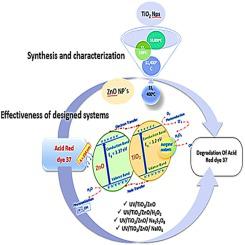Process Safety and Environmental Protection ( IF 6.9 ) Pub Date : 2021-03-01 , DOI: 10.1016/j.psep.2021.02.036 Hemmat A. Elbadawy , Wagih A. Sadik , Amel F. Elhusseiny , Seham M. Hussein

|
This work aims to study the photocatalytic degradation of the textile dye pollutant, Acid Red 37, under UV irradiation in the bench scale batch photoreactor, designing an optimum system of nanometal oxides TiO2, ZnO and their mixtures with different weight ratios. The photocatalysts were synthesized and fully characterized by XRD, EDS and TEM. The photocatalytic degradation process was investigated as a function of pH, concentration of the dye pollutant and different ratios of the photocatalytic mixtures. Furthermore, the effect of adding electron scavengers; H2O2, Na2S2O8 and NaIO4 was studied. The best photodegradation was observed under UV irradiation upon adding a ratio of (3:1) (TiO2: ZnO) at pH = 6.5 when the textile dye concentration is 1.0 × 10-4 mol/L. The efficiency of the studied photocatalytic degradation systems can be arranged in the order: UV/ZnO < UV/TiO2< UV/TiO2/ZnO < UV/TiO2/ZnO/H2O2 < UV/TiO2/ZnO/ Na2S2O8 < UV/TiO2/ZnO/NaIO4. The system designated as UV/TiO2/ZnO/(1.1-5.5)x10-3M NaIO4 showed the highest photocatalytic degradation efficiency, with highest apparent quantum yield (11.1-16.6)% and the lowest electrical energy per order (37.0-22.2) kWh, indicating the lowest energy consumption relative to the other examined catalytic systems. Finally, these outcomes can be useful for photocatalysis with low depletion of electrical energy, greater amount of degradation and economical procedure.
中文翻译:

低能耗,高量子产率的经济型光催化降解酸性红37纺织染料的系统设计
这项工作的目的是研究在台式规模的分批光反应器中在紫外线照射下纺织品染料污染物酸性红37的光催化降解,设计了一种最佳的纳米金属氧化物TiO 2,ZnO及其不同重量比的混合物的最佳体系。合成了光催化剂,并通过XRD,EDS和TEM对其进行了全面表征。研究了光催化降解过程与pH值,染料污染物浓度以及光催化混合物不同比例的关系。此外,添加电子清除剂的效果;H 2 O 2,Na 2 S 2 O 8和NaIO 4被研究了。当纺织品染料浓度为1.0×10 -4 mol / L时,在pH = 6.5的条件下添加(3:1)(TiO 2:ZnO)的比例,在UV照射下观察到最佳的光降解。研究的光催化降解系统的效率可以按以下顺序排列:UV / ZnO <UV / TiO 2 <UV / TiO 2 / ZnO <UV / TiO 2 / ZnO / H 2 O 2 <UV / TiO 2 / ZnO / Na 2 S 2 O 8 <UV / TiO 2 / ZnO / NaIO 4。指定为UV / TiO 2 / ZnO /(1.1-5.5)x10 -3 M NaIO的系统图4显示了最高的光催化降解效率,具有最高的表观量子产率(11.1-16.6)%和最低的每阶电能(37.0-22.2)kWh,表明相对于其他检查的催化系统,能耗最低。最后,这些结果对于以低的电能消耗,大量的降解和经济的程序进行光催化可能是有用的。











































 京公网安备 11010802027423号
京公网安备 11010802027423号